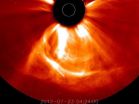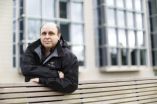(Press-News.org) Earth dodged a huge magnetic bullet from the sun on July 23, 2012.
According to University of California, Berkeley, and Chinese researchers, a rapid succession of coronal mass ejections – the most intense eruptions on the sun – sent a pulse of magnetized plasma barreling into space and through Earth's orbit. Had the eruption come nine days earlier, it would have hit Earth, potentially wreaking havoc with the electrical grid, disabling satellites and GPS, and disrupting our increasingly electronic lives.
The solar bursts would have enveloped Earth in magnetic fireworks matching the largest magnetic storm ever reported on Earth, the so-called Carrington event of 1859. The dominant mode of communication at that time, the telegraph system, was knocked out across the United States, literally shocking telegraph operators. Meanwhile, the Northern Lights lit up the night sky as far south as Hawaii.
In a paper appearing today (Tuesday, March 18) in the journal Nature Communications, former UC Berkeley postdoctoral fellow and research physicist Ying D. Liu, now a professor at China's State Key Laboratory of Space Weather, UC Berkeley research physicist Janet G. Luhmann and their colleagues report their analysis of the magnetic storm, which was detected by NASA's STEREO A spacecraft.
"Had it hit Earth, it probably would have been like the big one in 1859, but the effect today, with our modern technologies, would have been tremendous," said Luhmann, who is part of the STEREO (Solar Terrestrial Observatory) team and based at UC Berkeley's Space Sciences Laboratory.
A study last year estimated that the cost of a solar storm like the Carrington Event could reach $2.6 trillion worldwide. A considerably smaller event on March 13, 1989, led to the collapse of Canada's Hydro-Quebec power grid and a resulting loss of electricity to six million people for up to nine hours.
"An extreme space weather storm – a solar superstorm – is a low-probability, high-consequence event that poses severe threats to critical infrastructures of the modern society," warned Liu, who is with the National Space Science Center of the Chinese Academy of Sciences in Beijing. "The cost of an extreme space weather event, if it hits Earth, could reach trillions of dollars with a potential recovery time of 4-10 years. Therefore, it is paramount to the security and economic interest of the modern society to understand solar superstorms."
Based on their analysis of the 2012 event, Liu, Luhmann and their STEREO colleagues concluded that a huge outburst on the sun on July 22 propelled a magnetic cloud through the solar wind at a peak speed of more than 2,000 kilometers per second – four times the typical speed of a magnetic storm. It tore through Earth's orbit but, luckily, Earth and the other planets were on the other side of the sun at the time. Any planets in the line of sight would have suffered severe magnetic storms as the magnetic field of the outburst tangled with the planets' own magnetic fields.
The researchers determined that the huge outburst resulted from at least two nearly simultaneous coronal mass ejections (CMEs), which typically release energies equivalent to that of about a billion hydrogen bombs. The speed with which the magnetic cloud plowed through the solar wind was so high, they concluded, because another mass ejection four days earlier had cleared the path of material that would have slowed it down.
"The authors believe this extreme event was due to the interaction of two CMEs separated by only 10 to 15 minutes," said Joe Gurman, the project scientist for STEREO at NASA's Goddard Space Flight Center in Greenbelt, Md.
One reason the event was potentially so dangerous, aside from its high speed, is that it produced a very long-duration, southward-oriented magnetic field, Luhmann said. This orientation drives the largest magnetic storms when they hit Earth because the southward field merges violently with Earth's northward field in a process called reconnection. Storms that normally might dump their energy only at the poles instead dump it into the radiation belts, ionosphere and upper atmosphere and create auroras down to the tropics.
"These gnarly, twisty ropes of magnetic field from coronal mass ejections come blasting from the sun through the ambient solar system, piling up material in front of them, and when this double whammy hits Earth, it skews the Earth's magnetic field to odd directions, dumping energy all around the planet," she said. "Some of us wish Earth had been in the way; what an experiment that would have been."
"People keep saying that these are rare natural hazards, but they are happening in the solar system even though we don't always see them," she added. "It's like with earthquakes – it is hard to impress upon people the importance of preparing unless you suffer a magnitude 9 earthquake."
All this activity would have been missed if STEREO A – the STEREO spacecraft ahead of us in Earth's orbit and the twin to STEREO B, which trails in our orbit – had not been there to record the blast.
The goal of STEREO and other satellites probing the magnetic fields of the sun and Earth is to understand how and why the sun sends out these large solar storms and to be able to predict them during the sun's 11-year solar cycle. This event was particularly unusual because it happened during a very calm solar period.
"Observations of solar superstorms have been extremely lacking and limited, and our current understanding of solar superstorms is very poor," Liu said. "Questions fundamental to solar physics and space weather, such as how extreme events form and evolve and how severe it can be at the Earth, are not addressed because of the extreme lack of observations."
INFORMATION:
The work was supported by NASA.
Fierce 2012 magnetic storm barely missed Earth
A perfect storm of events created a massive magnetic cloud that could have caused fireworks on Earth
2014-03-18
ELSE PRESS RELEASES FROM THIS DATE:
New statistical models could lead to better predictions of ocean patterns
2014-03-18
COLUMBIA, Mo. – The world's oceans cover more than 72 percent of the earth's surface, impact a major part of the carbon cycle, and contribute to variability in global climate and weather patterns. However, accurately predicting the condition of the ocean is limited by current methods. Now, researchers at the University of Missouri have applied complex statistical models to increase the accuracy of ocean forecasting that can influence the ways in which forecasters predict long-range events such as El Nińo and the lower levels of the ocean food chain—one of the world's ...
Early detection of childhood eye cancer doesn't always improve survival, prevent eye loss
2014-03-18
For the most common form of childhood eye cancer, unilateral retinoblastoma, shortening the time from the first appearance of symptoms to diagnosis of disease has no bearing on survival or stage of the disease, according to a study by researchers at Columbia University Mailman School of Public Health in partnership with the Hospital Infantil de Mexico. The results appear online in the journal Cancer Epidemiology, Biomarkers & Prevention.
Because retinoblastoma is easily detectable by shining a light into a child's eye—often as a "cat's eye" reflection revealed through ...
The precise reason for the health benefits of dark chocolate: Mystery solved
2014-03-18
DALLAS, March 19, 2014 — The health benefits of eating dark chocolate have been extolled for centuries, but the exact reason has remained a mystery –– until now. Researchers reported here today that certain bacteria in the stomach gobble the chocolate and ferment it into anti-inflammatory compounds that are good for the heart.
Their findings were unveiled at the 247th National Meeting & Exposition of the American Chemical Society (ACS), the world's largest scientific society. The meeting, attended by thousands of scientists, features more than 10,000 reports on new advances ...
Building heart tissue that beats
2014-03-18
DALLAS, March 18, 2014 — When a heart gets damaged, such as during a major heart attack, there's no easy fix. But scientists working on a way to repair the vital organ have now engineered tissue that closely mimics natural heart muscle that beats, not only in a lab dish but also when implanted into animals. They presented their latest results at the 247th National Meeting & Exposition of the American Chemical Society (ACS), the world's largest scientific society.
The talk was one of more than 10,000 being presented at the meeting, which continues here through Thursday.
"Repairing ...
Bees capable of learning feats with tasty prize in sight
2014-03-18
They may have tiny brains, but bumblebees are capable of some remarkable learning feats, especially when they might get a tasty reward, according to two studies by University of Guelph researchers.
PhD student Hamida Mirwan and Prof. Peter Kevan, School of Environmental Sciences, are studying bees' ability to learn by themselves and from each other.
In the first study, published in February in Animal Cognition, the researchers found bees capable of learning to solve increasingly complex problems.
The researchers presented bees with a series of artificial flowers that ...
Sauder research shows why innovation takes a nosedive
2014-03-18
A new UBC study reveals that corporate leaders are victims of herd mentality when adopting new innovations, sometimes with deadly consequences.
The paper, by Sauder School of Business Associate Professor Marc-David L. Seidel and INSEAD Professor Henrich R. Greve, shows leaders tend to pursue innovations, even as complex as airplanes, based on early adoption by competitors not close scrutiny of the technical merits.
"Business leaders tend to panic when new innovations are about to hit the market. They scramble to buy an apparent early leader," says Seidel. "Sometimes ...
Stanford researchers survey protein family that helps the brain form synapses
2014-03-18
Neuroscientists and bioengineers at Stanford are working together to solve a mystery: how does nature construct the different types of synapses that connect neurons -- the brain cells that monitor nerve impulses, control muscles and form thoughts.
In a paper published in the Proceedings of the National Academy of Sciences, Thomas C. Südhof, M.D., a professor of molecular and cellular physiology, and Stephen R. Quake, a professor of bioengineering, describe the diversity of the neurexin family of proteins.
Neurexins help to create the synapses that connect neurons. Think ...
TGen-led study spotlights dog DNA role in developing new therapies for human cancers
2014-03-18
PHOENIX, Ariz. — March 17, 2014 — Using genomic analysis to study cancer in dogs can help develop new therapies for humans with cancer, according to a proof-of-concept study led by the National Cancer Institute (NCI) and the Translational Genomics Research Institute (TGen).
Pure-breed dogs, whose genetics have been standardized by hundreds of years of human intervention, provide highly predictable genetic models useful in designing clinical trials, in which specific drugs are matched to the molecular profiles of human patients, according to the study published today in ...
Kessler Foundation researchers link body temperature to relapsing-remitting MS and fatigue
2014-03-18
West Orange, NJ. March 18, 2014. Kessler Foundation researchers have demonstrated for the first time ever that body temperature is elevated endogenously in relapsing-remitting multiple sclerosis (RRMS) and linked to worse fatigue. The article was published ahead of print on Feb. 21, 2014 in Archives of Physical Medicine & Rehabilitation. Sumowski J, Leavitt V: Body temperature is elevated and linked to fatigue in relapsing-remitting multiple sclerosis, even without heat exposure. doi:10.1016/j.apmr.2014.02.004.
Researchers measured body temperature in 50 patients with ...
NIST chips help BICEP2 telescope find direct evidence of origin of the universe
2014-03-18
The view back in time—way back to the origins of the universe—just got clearer. Much clearer.
A team of U.S. cosmologists using the BICEP2 telescope at the South Pole announced this week that they have discovered the first direct evidence of the rapid inflation of the universe at the dawn of time, thanks in part to technology developed and built by the National Institute of Standards and Technology (NIST).
The BICEP2 camera relies, in part, on the extraordinary signal amplification made possible by NIST's superconducting quantum interference devices (SQUIDs).
The ...
LAST 30 PRESS RELEASES:
School meals could unlock major gains for human and planetary health
Menopause hormone therapy does not appear to impact dementia risk
Signature patterns of brain activity may help predict recovery from traumatic brain injury
Dresden study uncovers new key mechanism in cancer cells
New species are now being discovered faster than ever before, study suggests
Cannabis-based products show limited short-term benefit for chronic pain, with increased risk of adverse effects
Cannabis products with more THC slightly reduce pain but cause more side effects
Clearing the brain of aging cells could aid epilepsy and reduce seizures
Brain injuries linked with potential risk of suicide, new study finds
New technique lights up where drugs go in the body, cell by cell
New study finds movement of fishing fleets can reveal shifts in marine ecosystems
Embargoed: New evidence points to potential treatment for vascular dementia
Study uncovers disrupted brain balance in alcohol dependence
Working in groups can help Republicans and Democrats agree on controversial content moderation online
Structural findings reveal how distinct GPCR ligands create different levels of activation
Anything-goes “anyons” may be at the root of surprising quantum experiments
UC review: Maximizing workplace opportunity for veterans
From generation to complex control: Metasurfaces make perfect vortex beams "within reach"
Thin-film lithium niobate-based detector: recent advances and perspectives
Exploring why some people may tend to persistently make bad choices
How cells balance their protein levels
Nirsevimab vs RSVpreF vaccine for RSV–related hospitalization in newborns
Effectiveness and impact of maternal RSV immunization and nirsevimab on medically attended RSV in US children
AI gives scientists a boost, but at the cost of too many mediocre papers
Next-generation vision model maps tree growth at sub-meter precision
Genes aren’t destiny for inherited blindness, study shows
MIT study: High-fat diets make liver cells more likely to become cancerous
Exposure to multiple fine particulate matter components and incident depression in the US Medicare population
Risk of burdensome health care spending over time in the US
Nirsevimab against hospitalizations and emergency department visits for lower respiratory tract infection in infants
[Press-News.org] Fierce 2012 magnetic storm barely missed EarthA perfect storm of events created a massive magnetic cloud that could have caused fireworks on Earth





